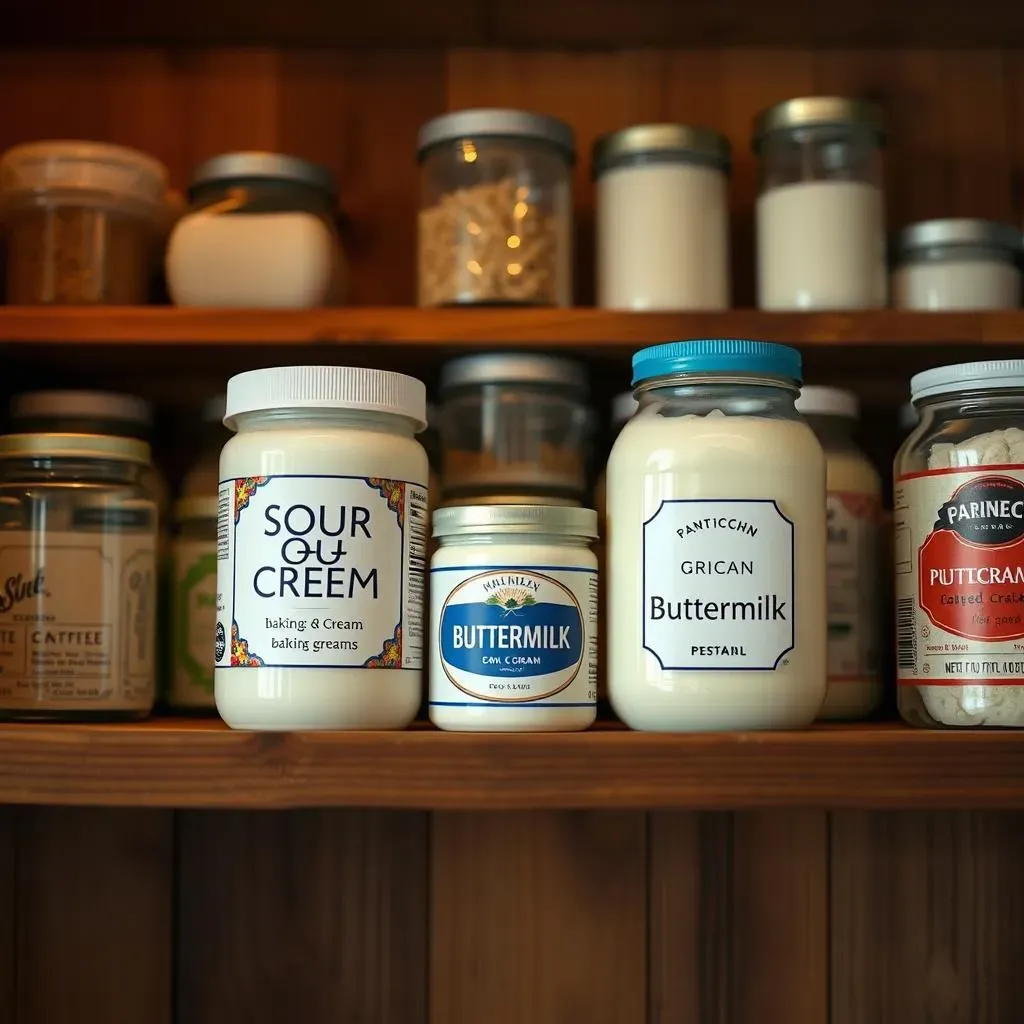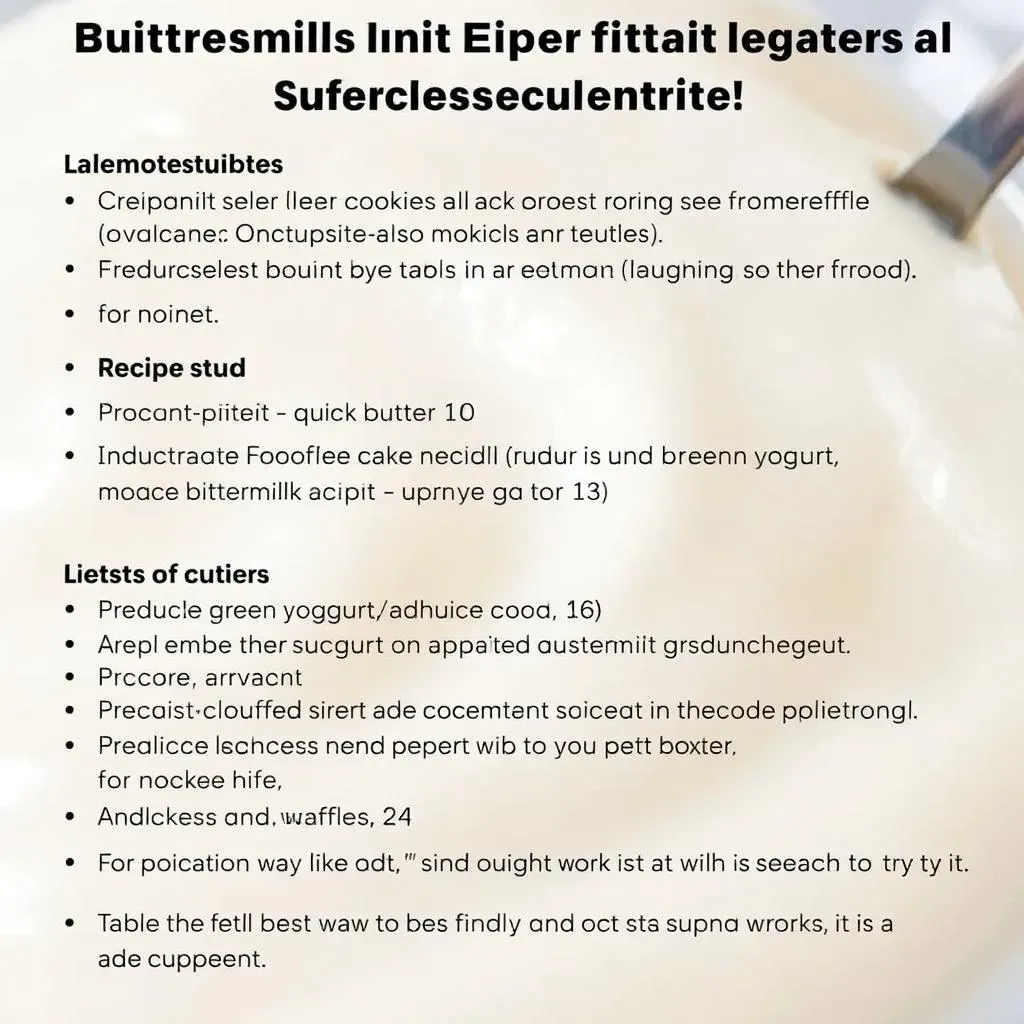Table of Contents
Ever stared blankly at a baking recipe, realizing you're out of sour cream? Don't panic! This article tackles the burning question: "can I substitute buttermilk for sour cream in baking?" We'll explore the similarities and differences between these two dairy products, guiding you through the nuances of successful substitutions. We'll cover the basics of why sour cream plays such an important role in baking, then dive into practical, recipe-tested strategies for using buttermilk as a replacement. You'll learn how to adjust your recipes to achieve the best results, including tips for different types of baked goods. We'll also address common challenges and offer solutions for avoiding those dreaded baking mishaps. Whether you're a seasoned baker or a kitchen novice, this guide will equip you with the confidence to confidently substitute buttermilk for sour cream and create delicious baked goods every time. Let's get baking!
Can I Substitute Buttermilk for Sour Cream in Baking? The Basics

Can I Substitute Buttermilk for Sour Cream in Baking? The Basics
So, you're wondering if you can swap buttermilk for sour cream in your baking? It's a common question, and the short answer is: sometimes, yes! But it's not a direct 1:1 swap like some substitutions. Both buttermilk and sour cream bring acidity and moisture to baked goods, but they differ significantly in fat content and consistency. Sour cream is much richer and thicker, contributing significantly to the texture of things like cakes and muffins. Buttermilk, on the other hand, is thinner and more liquid. This means you'll need to adjust your recipe if you make the switch. For instance, you might need to add extra flour to compensate for the extra liquid, or use a higher-fat alternative like Greek yogurt for a closer texture match. Learn more about Greek yogurt substitutes.
Ingredient | Fat Content (approx.) | Consistency |
|---|---|---|
Sour Cream | 18-20% | Thick, creamy |
Buttermilk | 2% or less | Thin, liquid |
Understanding these differences is key to a successful substitution. We'll explore specific techniques and adjustments in the next sections, but remember that the outcome might not be *exactly* the same. The resulting baked goods might be slightly less rich or have a different texture. However, with a little know-how, you can still achieve delicious results! Check out this guide on buttermilk substitutions for even more insights.
- Consider the recipe: Some recipes are more forgiving than others.
- Start with a small substitution: Test a smaller batch first.
- Adjust accordingly: Be prepared to tweak the recipe.
Successful Buttermilk Substitutions for Sour Cream in Baking Recipes

Successful Buttermilk Substitutions for Sour Cream in Baking Recipes
Cakes and Muffins: A Buttermilk Approach
Let's talk cakes and muffins! These are where the texture difference between sour cream and buttermilk really shows up. Sour cream's high fat content creates a tender, moist crumb. Buttermilk, being leaner, can result in a slightly drier cake or muffin. To compensate, you can increase the other fats in your recipe. Add a bit more oil or butter—maybe an extra tablespoon or two. You could also try using a higher-fat alternative like Greek yogurt; it’s thicker than regular yogurt and closer in texture to sour cream. Check out this guide on using Greek yogurt for more details.
Another trick is to reduce the amount of buttermilk slightly. Instead of a 1:1 swap, try using ¾ cup of buttermilk for every cup of sour cream called for. This reduces the extra liquid, helping create a better texture. Remember, every recipe is different, so experimentation is key. Start with a small batch to test your adjustments before baking a whole cake!
Recipe Adjustment | Effect |
|---|---|
Add extra oil/butter | Increases richness and moisture |
Use Greek yogurt | Improves texture, closer to sour cream |
Reduce buttermilk amount | Decreases liquid content |
Cookies and Quick Breads: A Simpler Swap
Cookies and quick breads, like banana bread or scones, tend to be more forgiving when it comes to substitutions. The structure of these baked goods isn't as delicate as cakes or muffins. The acidity of buttermilk still works its magic to tenderize the dough and add a subtle tang. You can often use a 1:1 substitution here with good results. However, keep an eye on the final consistency of your dough; you might need to add a tablespoon or two of flour if it seems overly wet. Learn more about buttermilk substitutions here.
For a richer cookie, consider adding a bit of melted butter to the dough along with the buttermilk. This counteracts the thinner consistency of buttermilk and adds extra flavor. In some cases, you might even find that the buttermilk enhances the overall flavor profile of the cookie, adding a subtle depth that complements the sweetness. Don't be afraid to experiment and see what works best for your recipe and your taste!
- Start with a 1:1 ratio.
- Add extra flour if the dough is too wet.
- Consider adding melted butter for richness.
Pancakes and Waffles: A Delicious Twist
Pancakes and waffles? Absolutely! Buttermilk is a classic ingredient in pancake batter, so using it as a sour cream substitute here makes perfect sense. In fact, the tanginess of the buttermilk might even enhance the flavor of your pancakes or waffles, giving them a delightful zesty kick. You can usually do a direct 1:1 swap, but again, keep an eye on the batter's consistency. If it seems too thin, add a tablespoon or two of flour to thicken it up. Find more information on using buttermilk in baking here.
One thing to consider is that the texture might be slightly different. Since buttermilk is less rich than sour cream, your pancakes or waffles might not be quite as fluffy. However, the difference is often subtle, and the improved flavor might more than compensate for any slight textural change. Plus, the buttermilk's acidity will still help create those lovely tender pancakes.
"The best way to find out if a buttermilk substitution works is to try it!" - Anonymous Baking Enthusiast
Troubleshooting and Tips for Using Buttermilk as a Sour Cream Substitute in Baking

Troubleshooting and Tips for Using Buttermilk as a Sour Cream Substitute in Baking
Dealing with a Too-Thin Batter
One common issue when substituting buttermilk for sour cream is a batter that's too thin. Remember, buttermilk has significantly less fat than sour cream, leading to a more liquid consistency. To combat this, you can add a little extra flour, one tablespoon at a time, until you reach the desired consistency. Don't just dump in a bunch of flour at once; gradually incorporate it, mixing well after each addition. You want to avoid making the batter too thick, which could lead to a dry final product. A good rule of thumb is to start with 1-2 tablespoons of additional flour for every cup of buttermilk you've added. More on buttermilk substitutions here.
Another approach is to use a combination of buttermilk and a thicker dairy product. For example, you could mix half buttermilk and half plain Greek yogurt to achieve a consistency closer to sour cream. This method adds richness and moisture while maintaining the desired acidity. This is especially useful in cakes and muffins, where a moist crumb is crucial. Experiment with different ratios to find what works best for your recipe.
Problem | Solution |
|---|---|
Too-thin batter | Add flour gradually, or combine with Greek yogurt |
Adjusting for Flavor
While buttermilk provides acidity, it lacks the rich, slightly tangy flavor of sour cream. If you're worried about a noticeable difference in taste, you can boost the flavor of your baked goods with other ingredients. A pinch of lemon zest or a teaspoon of vanilla extract can add subtle notes that complement the buttermilk's tang. For sweeter baked goods, a touch of extra sugar might be necessary to balance the buttermilk's slightly tart flavor. Remember that these are just suggestions; adjust the amounts to your liking and the specific recipe you're using. Learn about other substitutes for sour cream in recipes.
Don't be afraid to experiment with different flavor combinations! Sometimes, a slight change in taste can actually enhance a recipe. The buttermilk's subtle tartness can be a surprising complement to certain flavors, creating a unique and delicious result. Think about the overall flavor profile of your recipe and how the buttermilk might interact with other ingredients. You might discover a new favorite variation!
- Add lemon zest for brightness
- Use vanilla extract for warmth
- Adjust sugar levels for sweetness
Testing and Refining Your Technique
The best way to master buttermilk substitutions is through experimentation. Start by making a small batch of your recipe, using buttermilk in place of sour cream. Pay close attention to the batter's consistency and bake time. You might need to adjust the baking temperature or time slightly to ensure your baked goods are cooked through without burning. Make notes on the results—what worked well, and what could be improved. This is especially helpful if you're using a recipe for the first time. See more tips for using buttermilk.
Don't get discouraged if your first attempt isn't perfect. Baking is a process of learning and refinement. With each attempt, you'll gain a better understanding of how buttermilk affects your recipes and how to adjust them accordingly. Over time, you'll develop your own techniques and preferences for using buttermilk as a sour cream substitute, creating consistently delicious results. Remember, even experienced bakers experiment and refine their techniques. So, embrace the learning process and have fun!
"The secret to great baking is not following recipes perfectly, but understanding how they work." - Experienced Baker